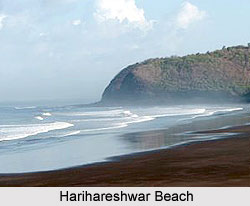 Shriwardhan - Harihareshwar is an unexplored beach on the Konkan coastline. Shriwardhan is a bay which the beach lovers would fall for. The adventurers can even take a small boat to the north side of the bay and explore a land where the Peshwas or Prime Ministers of the Maratha kingdom, originally resided. Shriwardhan - Harihareshwar is very popular for its sea food. The township of Harihareshwar is known for its tranquil and serene beach. This beach is ideal place for sun bathing and relaxing. It is total get away from the hustle and bustle of the city life. Tourism with a difference - Shriwardhan - Harihareshwar offers beach tourism. It is a beautiful and clean beach along the Konkan coast. The temple of Lord Harihareshwar is also quite famous.
Shriwardhan - Harihareshwar is an unexplored beach on the Konkan coastline. Shriwardhan is a bay which the beach lovers would fall for. The adventurers can even take a small boat to the north side of the bay and explore a land where the Peshwas or Prime Ministers of the Maratha kingdom, originally resided. Shriwardhan - Harihareshwar is very popular for its sea food. The township of Harihareshwar is known for its tranquil and serene beach. This beach is ideal place for sun bathing and relaxing. It is total get away from the hustle and bustle of the city life. Tourism with a difference - Shriwardhan - Harihareshwar offers beach tourism. It is a beautiful and clean beach along the Konkan coast. The temple of Lord Harihareshwar is also quite famous.
This beach is also landmark by Kalbhairav - the Lord Shiva Temple. Peshwa smarak and the Bankot fort are just 4 km away from the beach. It is a must see place. Bankot fort is located in a place called Bagmandala. The soft sands and the breeze make Shriwardhan Bay an ideal place for sun bathing. Forms Of Tourist Attraction In Shriwardhan - Harihareshwar Shriwardhan - Harihareshwar is an unpolluted beach. The Shiva temple is old and the construction period has not been clear. It is believed that the temple could have been constructed during Shivaji`s period.
Later it was re-constructed in 1723 by first Bajirao Peshwa. Idols of Lord Brahma - Lord Vishnu - Mahesh and Devi Parvathi can be seen inside the temple. It can be reached by rails and road. The nearest railhead is Mangoan on Konkan railway. From Mumbai, the total distance to Shriwardhan - Harihareshwar is around 200 km. There also good hotels that provide services with modern amenities. Tents are also made available, seasonally. One can get down at Shriwardhan and catch a private cab or rickshaw to reach Harihareshwar.
This article is a stub. You can enrich by adding more information to it. Send your Write Up to content@indianetzone.com



















